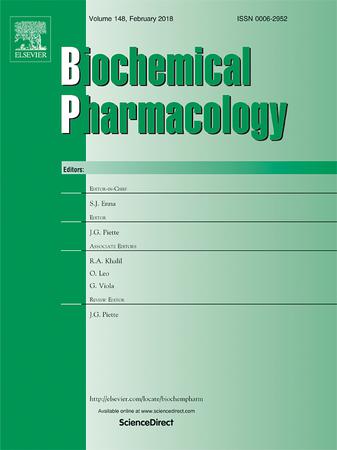多嘌呤逆转录hoogsteen发夹抑制PCSK9:一种新的基因治疗方法
IF 5.6
2区 医学
Q1 PHARMACOLOGY & PHARMACY
引用次数: 0
摘要
PCSK9是高胆固醇血症的治疗靶点。尽管有多种抑制PCSK9的策略,如单克隆抗体、小分子或核酸药物,但仍然需要更安全、更廉价的干预措施。我们开发了一种时间,成本和资源效率高的沉默系统,使用聚嘌呤反向Hoogsteen (PPRH)发夹靶向PCSK9。为了实现PCSK9的沉默,我们设计了两个针对PCSK9外显子9 (HpE9)和12外显子(HpE12)的PPRHs。通过EMSA测定PPRHs的结合能力:HpE9和HpE12的Kd值分别为7.86 x 10-8 M和7.58 x 10-7 M。PPRHs与阳离子聚合物jetPEI络合形成167 nm的粒子,并通过动态光散射进行表征。用HpE9和HpE12转染HepG2细胞,评价PCSK9基因和蛋白的表达。PPRHs在24小时内有效降低PCSK9 mRNA水平(HpE9和HpE12分别为63%和74%)和蛋白水平(分别为76%和87%)。注射单次HpE12的人PCSK9过表达小鼠在注射后第三天血浆PCSK9水平降低50%,并在第15天恢复到基线水平。血浆胆固醇水平在第三天降低了47%。与单独注射jetPEI的小鼠相比,接受PPRHs的小鼠在体重、肝酶或促炎标志物方面没有表现出变化。因此,PPRH技术作为一种创新的基于核酸的治疗方法出现,它有效、经济、易于开发,用于抑制PCSK9。本文章由计算机程序翻译,如有差异,请以英文原文为准。

Inhibition of PCSK9 with polypurine reverse hoogsteen hairpins: A novel gene therapy approach
PCSK9 is a therapeutic target for hypercholesterolemia. Though different strategies to inhibit PCSK9, such as monoclonal antibodies, small molecules, or nucleic acid drugs are available, the need for safer and inexpensive interventions remains. We developed a time-, cost-, and resource- efficient silencing system using Polypurine Reverse Hoogsteen (PPRH) hairpins to target PCSK9. To achieve PCSK9 silencing, we designed two PPRHs targeting PCSK9 at exon 9 (HpE9) and exon 12 (HpE12). The binding capabilities of PPRHs were measured by EMSA: Kd values were 7.86 x 10-8 M and 7.58 x 10-7 M for HpE9 and HpE12, respectively. PPRHs were complexed with the cationic polymer jetPEI forming particles of 167 nm as characterized by Dynamic Light Scattering. PCSK9 gene and protein expression was evaluated upon transfections of HepG2 cells with HpE9 and HpE12. PPRHs effectively reduced PCSK9 mRNA levels (63 % and 74 % for HpE9 and HpE12, respectively) and protein (by 76 % and 87 %) at 24 h. Human PCSK9 overexpressing mice receiving a single injection of HpE12 decreased plasma PCSK9 levels by 50 % by day three post injection and levels returned to baseline by day fifteen. Plasma cholesterol levels were reduced by 47 % by day three. Mice receiving the PPRHs did not exhibit changes in body weight, liver enzymes or pro-inflammatory markers when compared to mice injected with jetPEI alone. Therefore, the PPRH technology emerges as an innovative nucleic acid based therapeutic approach that is effective, cost-efficient and easy to develop, for the inhibition of PCSK9.
求助全文
通过发布文献求助,成功后即可免费获取论文全文。
去求助
来源期刊

Biochemical pharmacology
医学-药学
CiteScore
10.30
自引率
1.70%
发文量
420
审稿时长
17 days
期刊介绍:
Biochemical Pharmacology publishes original research findings, Commentaries and review articles related to the elucidation of cellular and tissue function(s) at the biochemical and molecular levels, the modification of cellular phenotype(s) by genetic, transcriptional/translational or drug/compound-induced modifications, as well as the pharmacodynamics and pharmacokinetics of xenobiotics and drugs, the latter including both small molecules and biologics.
The journal''s target audience includes scientists engaged in the identification and study of the mechanisms of action of xenobiotics, biologics and drugs and in the drug discovery and development process.
All areas of cellular biology and cellular, tissue/organ and whole animal pharmacology fall within the scope of the journal. Drug classes covered include anti-infectives, anti-inflammatory agents, chemotherapeutics, cardiovascular, endocrinological, immunological, metabolic, neurological and psychiatric drugs, as well as research on drug metabolism and kinetics. While medicinal chemistry is a topic of complimentary interest, manuscripts in this area must contain sufficient biological data to characterize pharmacologically the compounds reported. Submissions describing work focused predominately on chemical synthesis and molecular modeling will not be considered for review.
While particular emphasis is placed on reporting the results of molecular and biochemical studies, research involving the use of tissue and animal models of human pathophysiology and toxicology is of interest to the extent that it helps define drug mechanisms of action, safety and efficacy.
 求助内容:
求助内容: 应助结果提醒方式:
应助结果提醒方式:


